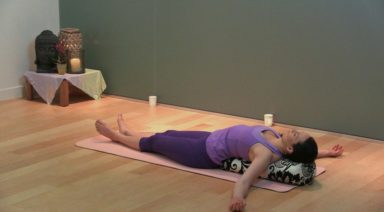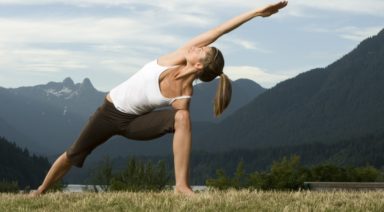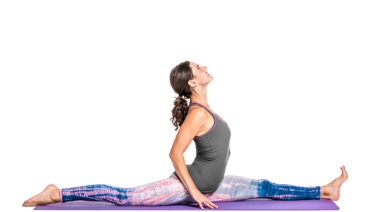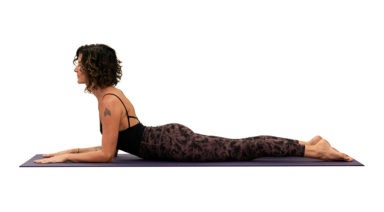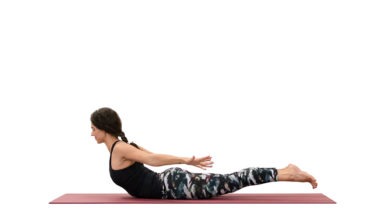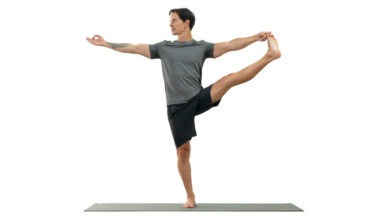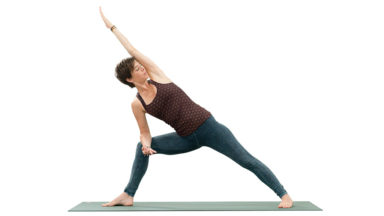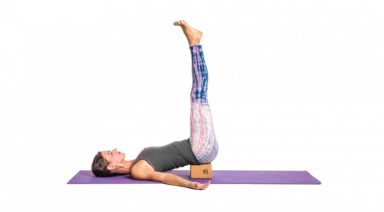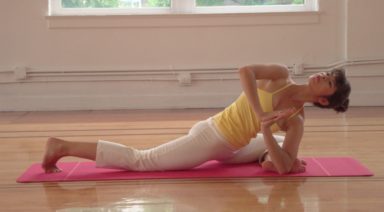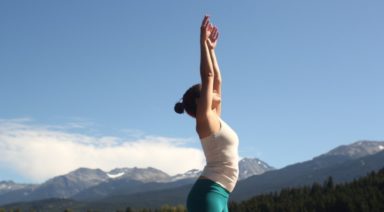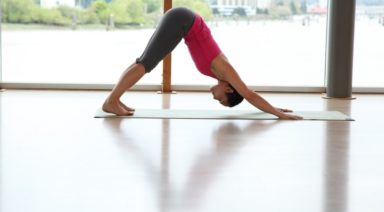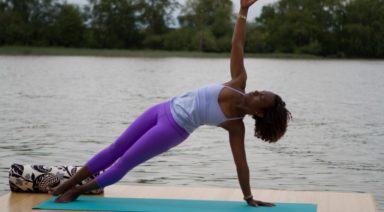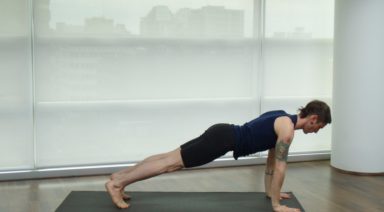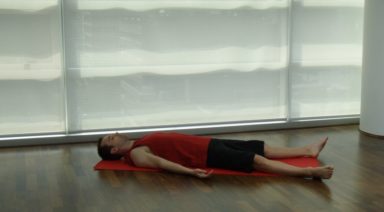Quadratus Lumborum and Mindful Back Health in Yoga

Low back pain is an increasing issue in our society dominated by poor posture, sedentary lifestyles, and chronic sitting patterns. The source of low back pain can vary, but a great deal of these muscular dysfunctions emanate from the quadratus lumborum muscles.
Most of us are quite familiar with the erector spinae muscles that travel from the hip crest/sacrum to various points up the vertebrae and ribs. These muscles function primarily as extensors of the back. Few people (including yoga teachers) are aware of the all-important quadratus lumborum muscles that are located deep toward the erector spinae.
The quadratus lumborum muscles sit on either side of the vertebrae. They originate on the iliac crest (hip bone) and insert on the transverse processes of the lumbar vertebrae and the 12th (last) rib.
When both sides contract, they extend the spine (and/or depress the ribcage from behind). When only one side contracts, the spine flexes laterally and/or elevates the ilium (hip) on that same side. In forced expiration, the quadratus lumborum will fix the 12 ribs.
When Back Pain Can Occur
Dysfunction and low back pain can settle into the quadratus lumborum under a few conditions:
- If the erector spinae are weak or inhibited (as they often are in chronic seated postures), the quadratus lumborum attempts to take up the slack and loading in back extension and spinal stabilization leading to overall muscle fatigue.
- If muscle imbalances build up across the pelvis (e.g., tight hip flexors), the lower vertebrae can shift into chronic excessive curvature (lordosis), which will shorten and weaken the quadratus lumborum and erector spinae.
- If poor posture and upper body muscle tension forms across the chest and shoulders, rounded-back posture (kyphosis) will pull the rib cage up and away from the hip crest. This places stress and drag on the quadratus lumborum and portions of the erector spinae.
- The deep gluteals (gluteus medius and gluteus minimus) are responsible for hip abduction and pelvic stabilization in walking and other gait patterns. If these deep gluteal muscles are weak and inhibited, the quadratus lumborum and tensor fascia latae have to compensate to stabilize the pelvis.
- Some physical experts have also found that tight hip adductor muscles (groin) can inhibit (through reciprocal inhibition) the gluteus medius muscles. As mentioned above, the quadratus lumborum muscle may compensate for the gluteus medius muscle’s lack of activity and pelvic stabilization.
How to Keep Your Back Healthy with Yoga
Understanding that the dysfunction residing in the quadratus lumborum is often the result of dysfunction and tension imbalances coming from other muscles, here are some initial approaches to maintaining health of the quadratus lumborum:
- Develop a strategy to maintain fluid balance in upper and lower body posture patterns to avoid chronic hip flexor tightness, back extensor tension, and loss of natural vertebral curvature and pelvic placement
- Stretch the chest, front of the shoulders, hip flexors, groin, and lower back frequently
- Strengthen back extensors and overall core stabilizers
- Strengthen and stretch deep gluteals to unload unnecessary engagement of the quadratus lumborum
- Engage in proper therapeutic treatments when discomfort and pain develop
Need help with yoga for back pain? Sign up for our Yoga Foundations Guide with Rodney Yee & Colleen Saidman Yee!
Do These Yoga Poses for Back Pain
Here are some basic, accessible stretches readily prescribed to restore and maintain flexibility in the quadratus lumborum muscles:
Child’s Pose
When aiming to stretch the quadratus lumborum muscles and other lower back musculature, I would personally recommend avoid using forward bends like Uttanasana (Standing Forward Bend), Paschimottasana (Seated Two Leg Forward Bend) and other similar poses.
Due to the nature of intervertebral disc compression in spinal flexion, these types of forward bends would be better served to actually involve engagement of the back extensors and transverse abdomen in order to extend the spine, shift the ‘flexion’ into the hips, unload the lower vertebrae and protect against disc compression.
Addiction Recovery Through Yoga
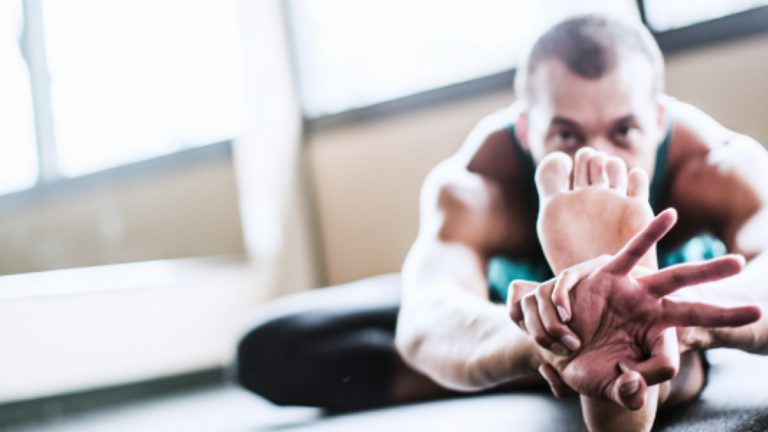
With all the images online of toned women in tights pulling themselves into pretzel-like poses, it’s easy to focus on the physical side of yoga, thinking of it as an exercise class that ends with a mini nap. But the ancient practice of yoga can also help with drug and alcohol addiction, diseases that affect millions of us in this fast-paced, modern world.
While yoga can be a powerful tool for personal transformation and recovery, many people write it off before even stepping onto a mat, saying they’re not flexible enough or they can’t afford the classes. Yet the mind-body connection, stress relief and personal growth that can occur through the regular practice of yoga can be just what a recovering addict needs. Yoga encourages a person to reconnect to their breath, body, mind and heart. Here are just a few ways yoga can help release the mind and body from the grips of drug and alcohol addiction.
Yoga Eases Stress
“It was such a crazy/stressful/hectic day… I need a drink” is such a common phrase in our culture, it’s easy to forget that there are healthy ways to cope with stress. Many addicts have become so dependent on their substance of choice, they’ve forgotten that movement or even just a few deep breaths can bring a real sense of calm to the day. And that moment of calm can lead to healthier choices as you move toward a sober life.
The benefits of mindful movement and breathing, which are at the center of many yoga classes, have been proven to increase overall health.
According to the American Institute of Stress, 20 to 30 minutes of deep breathing has been shown to help the body kick into a relaxation response, where stress levels drop and blood pressure decreases. “Deep breathing increases the supply of oxygen to your brain and stimulates the parasympathetic nervous system, which promotes a state of calmness,” according to an article on the organization’s website. “Breathing techniques help you feel connected to your body—it brings your awareness away from the worries in your head and quiets your mind.”
Nearly all yoga classes encourage students to consciously inhale and exhale, which brings peace to the mind and body, even as we move through a practice. If you commit even further, and regularly practice at home or at a studio, you might find yourself using deep breathing or a short yoga sequence to help you stay strong through a moment of temptation or stress.
This is especially important for addicts, as many suffer from post-acute withdrawal symptoms, or PAWS, in the early stages of recovery. These symptoms often include anxiety and mood swings. One study has shown that yoga directly helps to increase GABA, a neurotransmitter that aids in relaxing the nervous system, therefore improving your mood and decreasing anxiety.
Yoga Increases Self-Awareness
Addicts are often accused by their loved ones of being selfish. But devoting regular time to the kind of reflection that comes with yoga can be beneficial to those in recovery. More meditative types of the practice, like Yin Yoga, where there is little movement and just a few poses done in a single class, can create a meaningful space for really checking in with ourselves. While the questions that come to mind might not always be pleasant, these classes are set up as safe spaces for students to release emotions, and teachers are aware that their students might be struggling with all kinds of personal issues while in their studio. This type of contemplative yoga can help with anxiety, depression and even sleep issues. By dealing with some of the other factors that might be causing stress and unhappiness in your life, you might have more resolve or energy to commit to a recovery plan or time in a rehabilitation center.
Addressing the Roots of Addiction
Yoga is not superior in dealing with one addiction over another. Yoga begins to address the roots of a problem rather than the symptoms, making it a common tool among recovery from many addictions. If someone struggling with alcohol or drug addiction gets sober only to find him- or herself struggling with another addiction, such as food or gambling, yoga practices can be implemented to support in recovery from both addictions.
Yoga for General Wellbeing
Yoga can also be used as a tool to support general wellbeing regardless of addiction. For example, long deep breathing, or “yogic breathing,” has been shown to reduce levels of the stress hormone cortisol and increase stress resilience. Yoga can also be used to assist in dealing with trauma. According to Dr. Bessel van der Kolk, an expert in the field of trauma treatment, yoga may be more effective than many medications in treating PTSD. “Medication can be quite nice to sort of dampen some of the symptoms,” he states. “But in the end, people need to own their bodies, they need to own their physical experiences. And, in order to overcome your trauma, it needs to be safe to go inside and to experience yourself.”
Yoga asks you to show up for yourself. Although deep breathing can help relieve stress at any moment during the day, a physical yoga practice requires regularly carving out time for yourself. Even if you are just going to spend a few minutes stretching in your living room, you still must make the time to practice. As with any other type of physical exercise, you’ll see more benefits if you practice regularly. Yoga, for example, has been proven to ease chronic back pain and joint pain. Some studies have found that it can also help with mental health issues.
German researchers, for example, studied a small group of women who described themselves as “emotionally distressed.” Over a three-month period, they took two 90-minute yoga classes a week. At the end of the study, their stress, anxiety and overall health all improved. Similar studies have also shown the one-off benefits of even attending a single yoga class. The uniting factor in all of these cases? The participants showed up for themselves and attended a class. They might have had stressful days or felt anxiety about trying yoga or were plagued by depression, but they put all of that aside and spent the hour (or more) bending, breathing and stretching.
It’s easy to put off a yoga practice: to buy a mat or a DVD and let it go dusty. Or to attend a single class, but never step foot in the studio again. But the more you commit to yourself, and a regular mind-body practice, the more overall benefits you’ll begin to see and feel. A single healthy decision, like deciding to roll out your yoga mat, can change your focus for the day and encourage another healthy decision. Over time, those mindful moments will add up, perhaps leading to an overall more positive outlook and healthier lifestyle.
The Art of Surrender
Yoga requires us to surrender. The first of the 12 steps in Alcoholics Anonymous is “We admitted we were powerless over alcohol, that our lives had become unmanageable.” In a similar vein, yoga asks again and again that we drop everything that is not necessary in our lives. Most teachers will begin the class with a mind-clearing exercise and a short moment to set an intention. This helps us focus on the moment, and release all the other stresses in life. Similarly, some poses require surrender, as well.
Maybe there’s a complicated pose in class that you simply cannot twist your body into. That doesn’t mean you have to flop down on your mat or write the pose off for good. It simply means that accepting that today, that pose is not happening.
The same idea is true during some of the more “relaxing” poses. While your body might be still in a seated position, you may feel your mind racing. Again, yoga teaches us to simply surrender and to be present with who we are, where we are, right now. By engaging in a regular practice, we learn that acceptance comes with not being able to control the world around us but by allowing the world around us to exist as it is. By doing so we learn the art and gift of peaceful surrender.
In terms of learning to let go of expectations and limitations, yoga can be a boon for those who are recovering from addiction. In AA, the moment of surrender becomes “the firm bedrock upon which a happy and purposeful life is built.” The same is true in yoga: When we accept that a pose is out of our reach or that our minds cannot be quieted, we might finally find a moment of true freedom.




